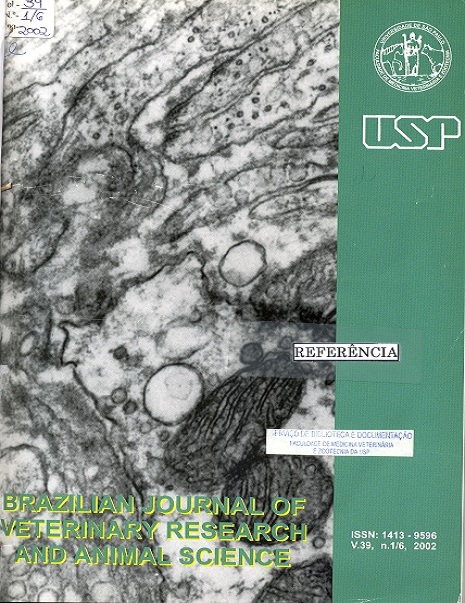Acaricide effect of Eucalyptus spp essential oils and concentrated emulsion on Boophilus microplus
DOI:
https://doi.org/10.1590/S1413-95962002000500006Keywords:
Boophilus microplus, Acaricides, Eucalyptus, Essential oils, Concentrated emulsionAbstract
Biocide action of Eucalyptus citriodora, Eucalyptus globulus and Eucalyptus staigeriana were studied against Boophilus microplus tick, aiming the production of an environmentally and ecologically conect and len harmpol acaricide. Essential oil emulsion of three Eucaliptus species were tested in five different concentrations against larvae and engorged female of B. microplus. Oils were submitted to gas chromatograph coupled to mass spectrometer (GC/MS) analysis looking for its composition. Citronelal is the major component of E. citriodora essential oil, being responsible for its acaricide action. The same happens with 1.8-cineole in E. globulus. In E. staigeriana, there are many substances involved in a synergic action against B. microplus. E. citriodora essential oil killed all ticks in an average concentration of 17.5% as compared to E. globulus with 15% and E. staigeriana with 12.5%. E. globulus concentrated emulsion killed all ticks in an average concentration of 9.9% and E. staigeriana in a concentration of 3.9%. Further steps will be pursued to make those essential oils to be tested under field conditions and available to the farmers, since bioacaricides has commercial appeal, allowing B. microplus control in a less aggressive way to the environment.Downloads
Download data is not yet available.
Downloads
Published
2002-01-01
Issue
Section
UNDEFINIED
License
The journal content is authorized under the Creative Commons BY-NC-SA license (summary of the license: https://
How to Cite
1.
Chagas AC de S, Passos WM, Prates HT, Leite RC, Furlong J, Fortes ICP. Acaricide effect of Eucalyptus spp essential oils and concentrated emulsion on Boophilus microplus. Braz. J. Vet. Res. Anim. Sci. [Internet]. 2002 Jan. 1 [cited 2025 Dec. 24];39(5):247-53. Available from: https://revistas.usp.br/bjvras/article/view/5956





